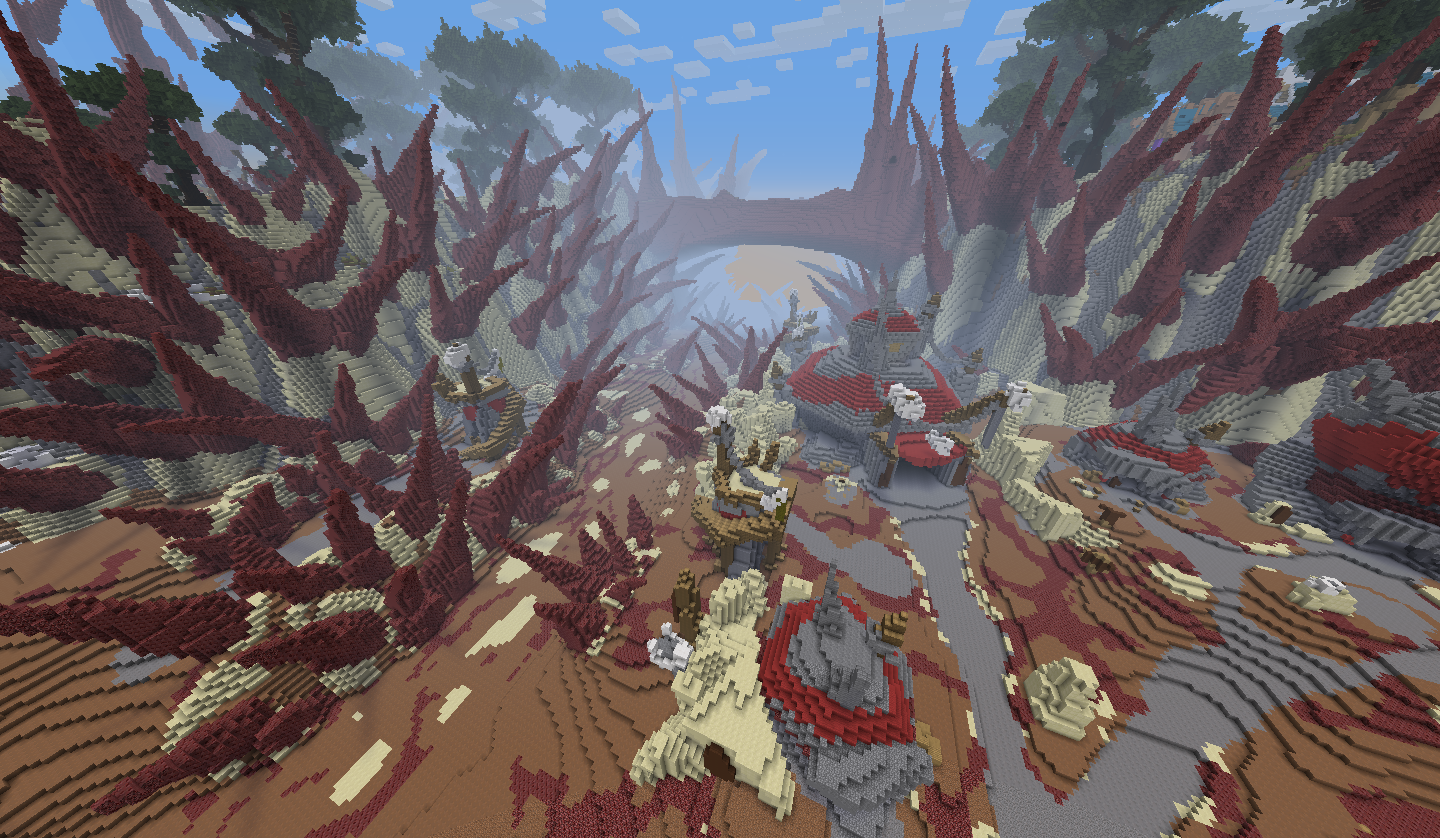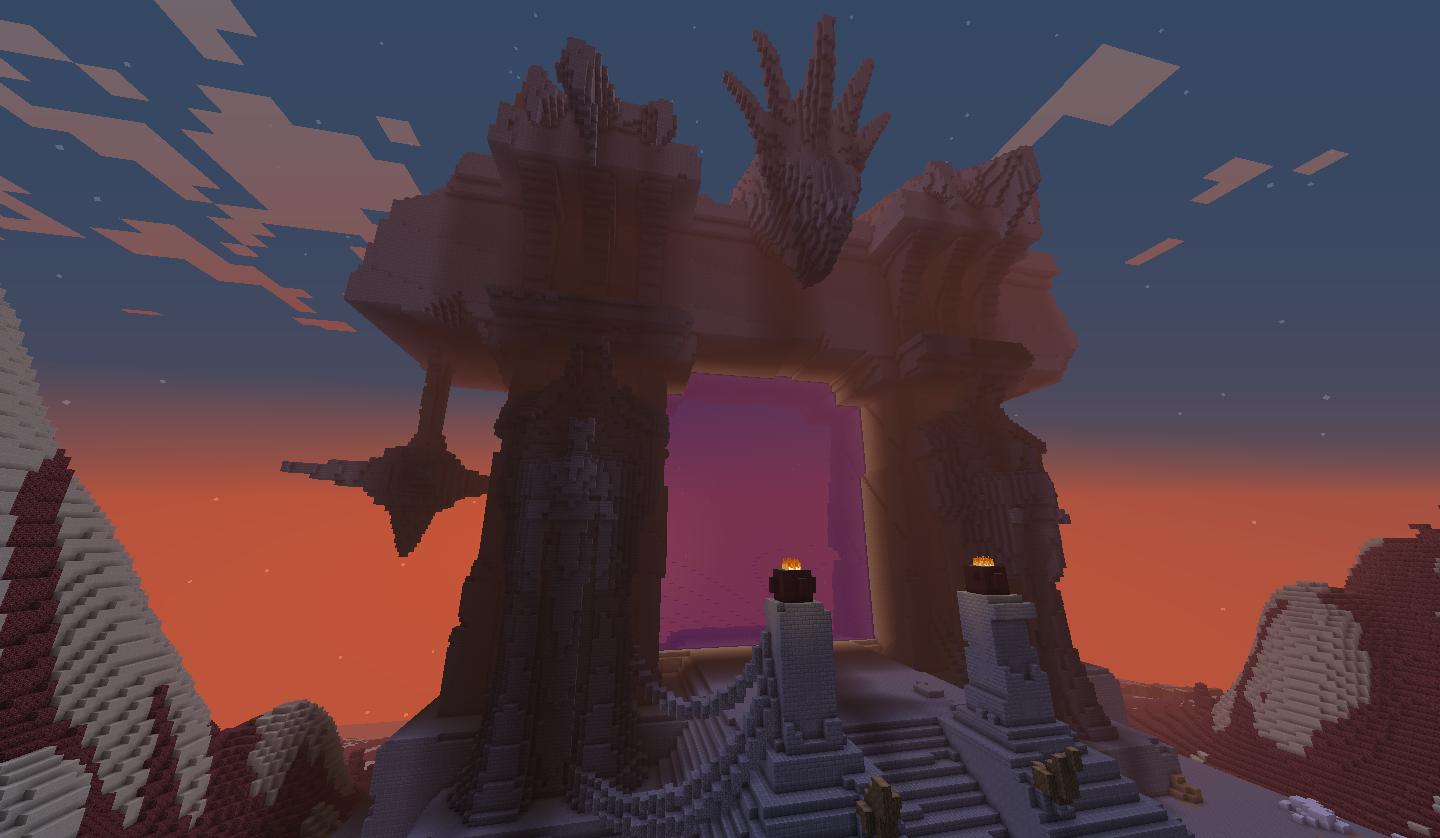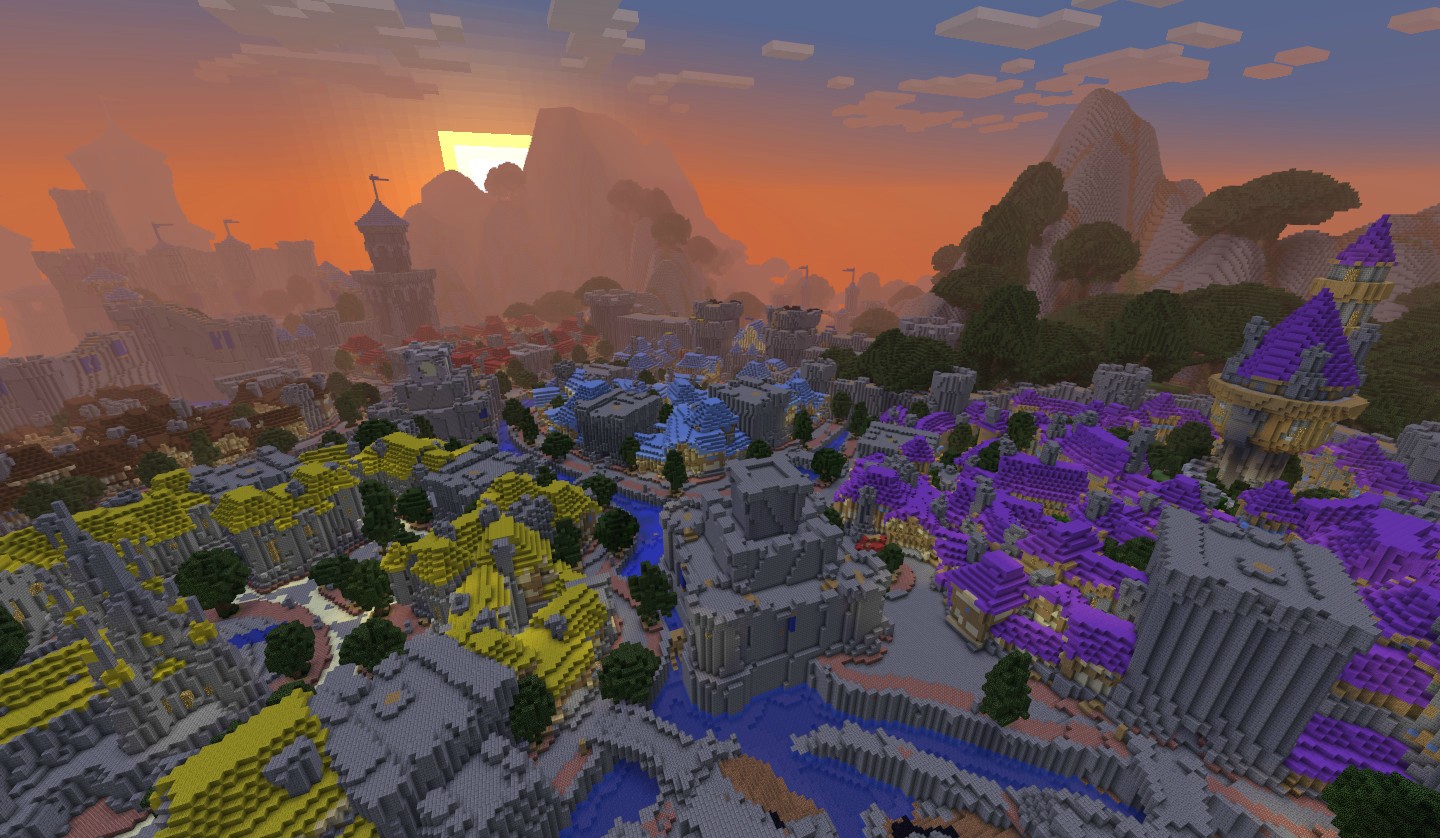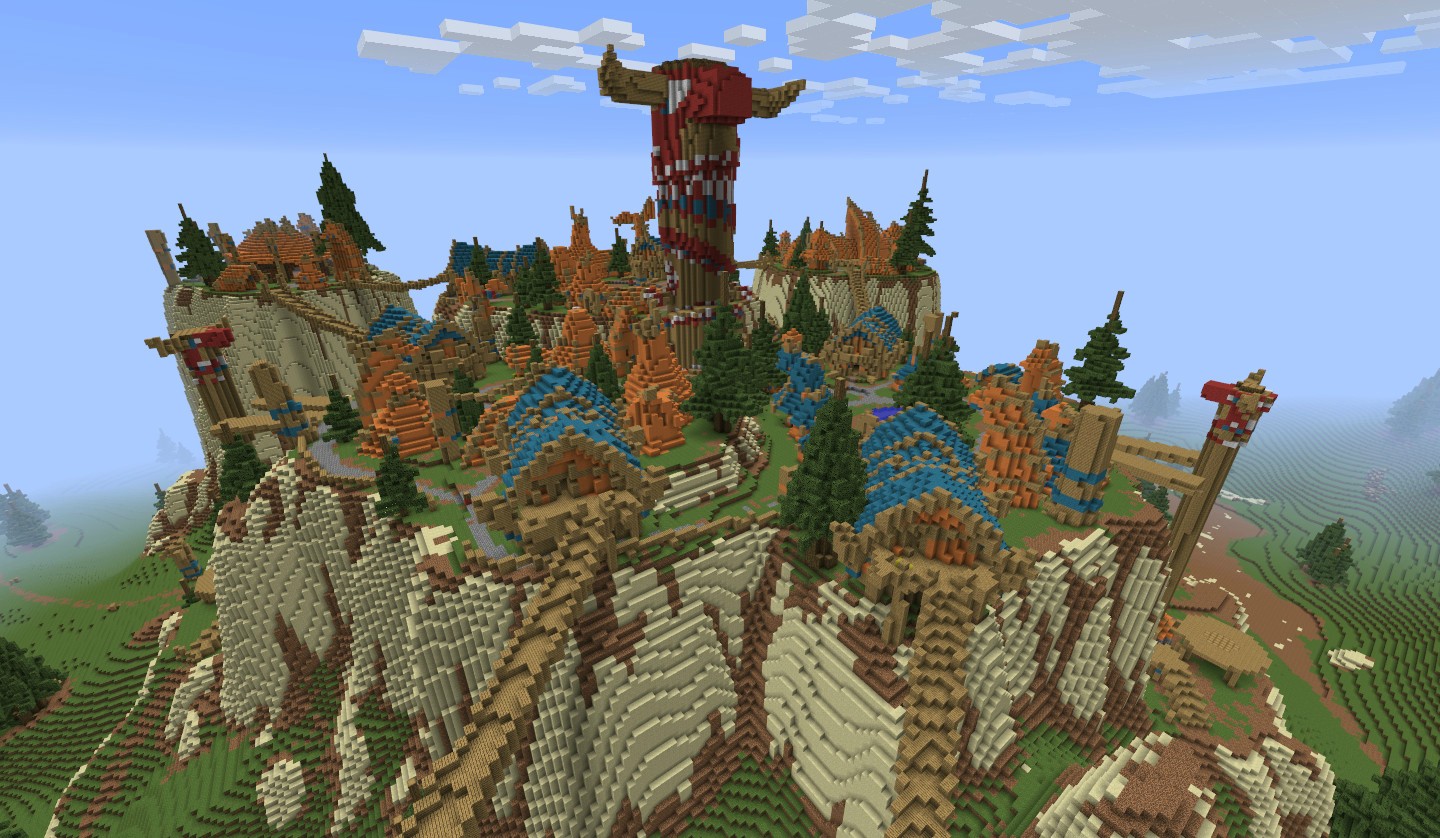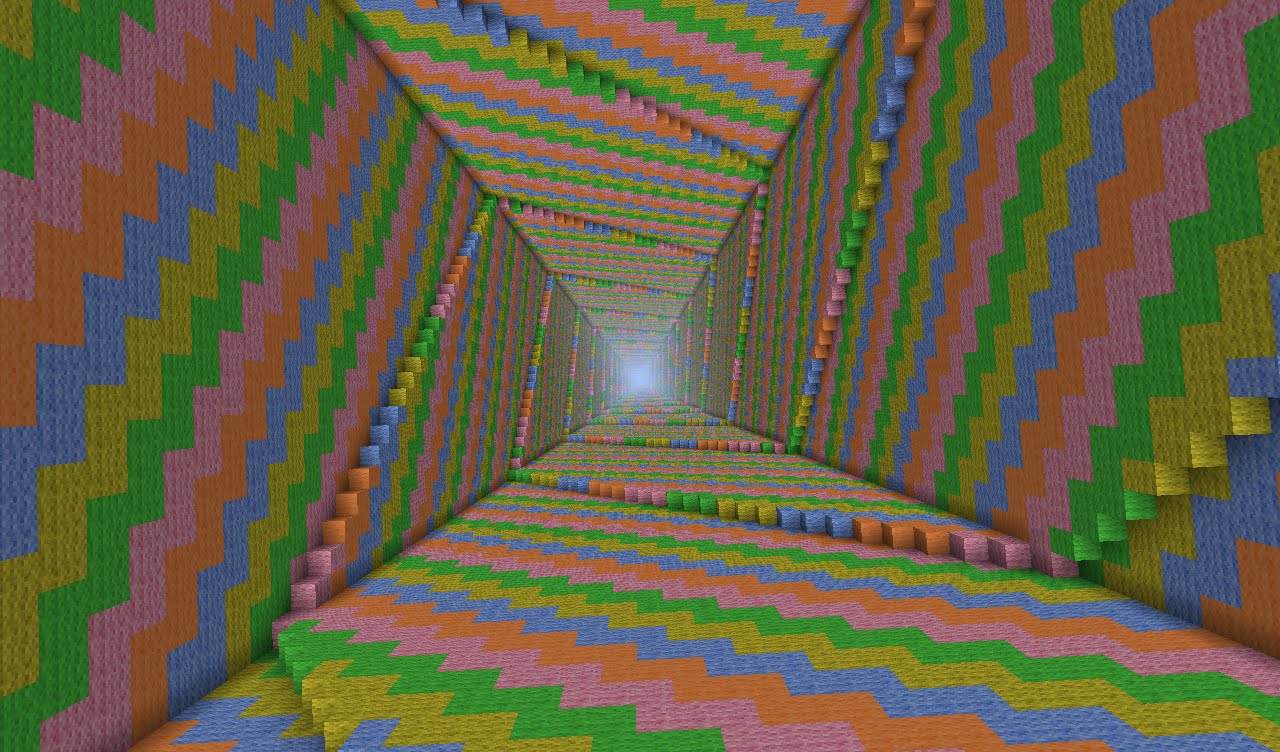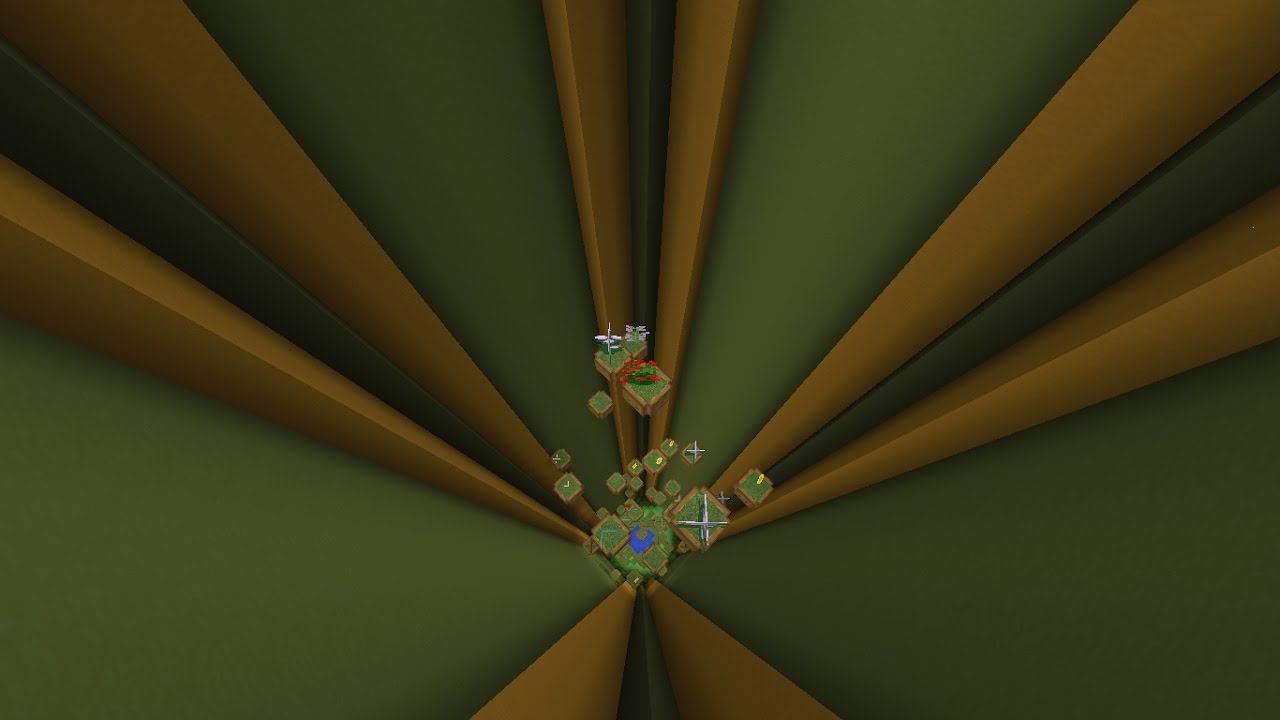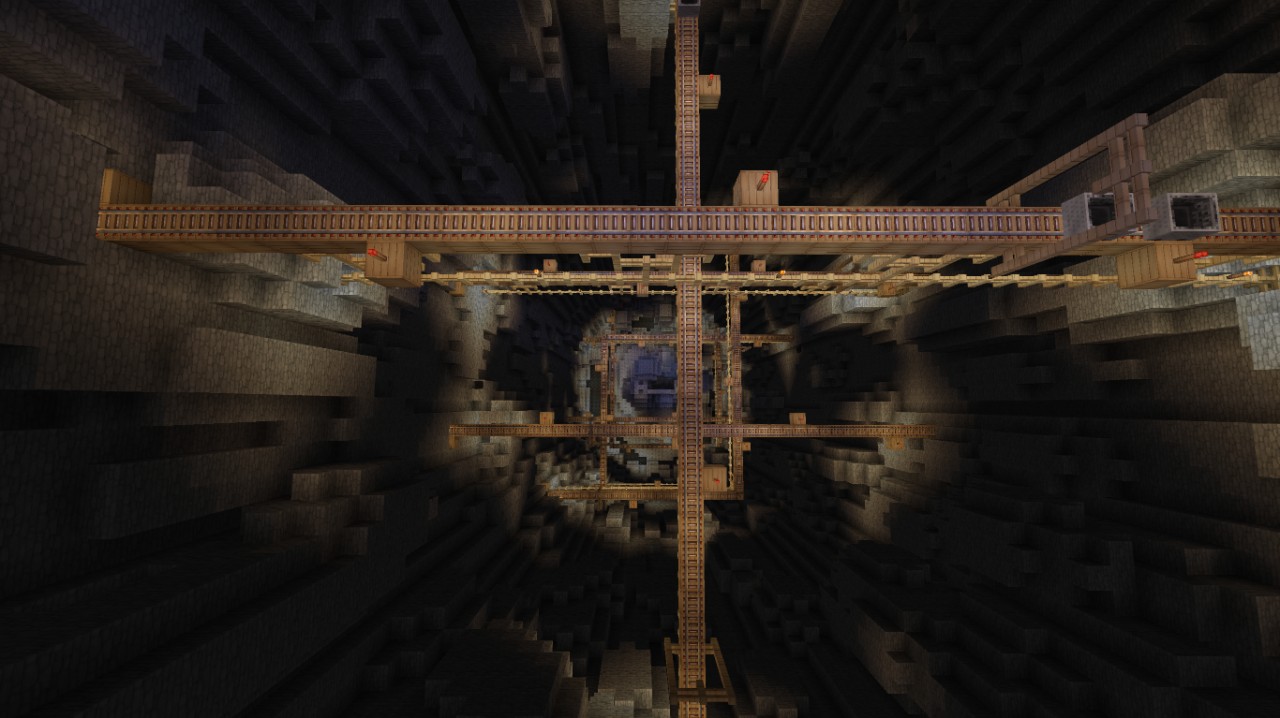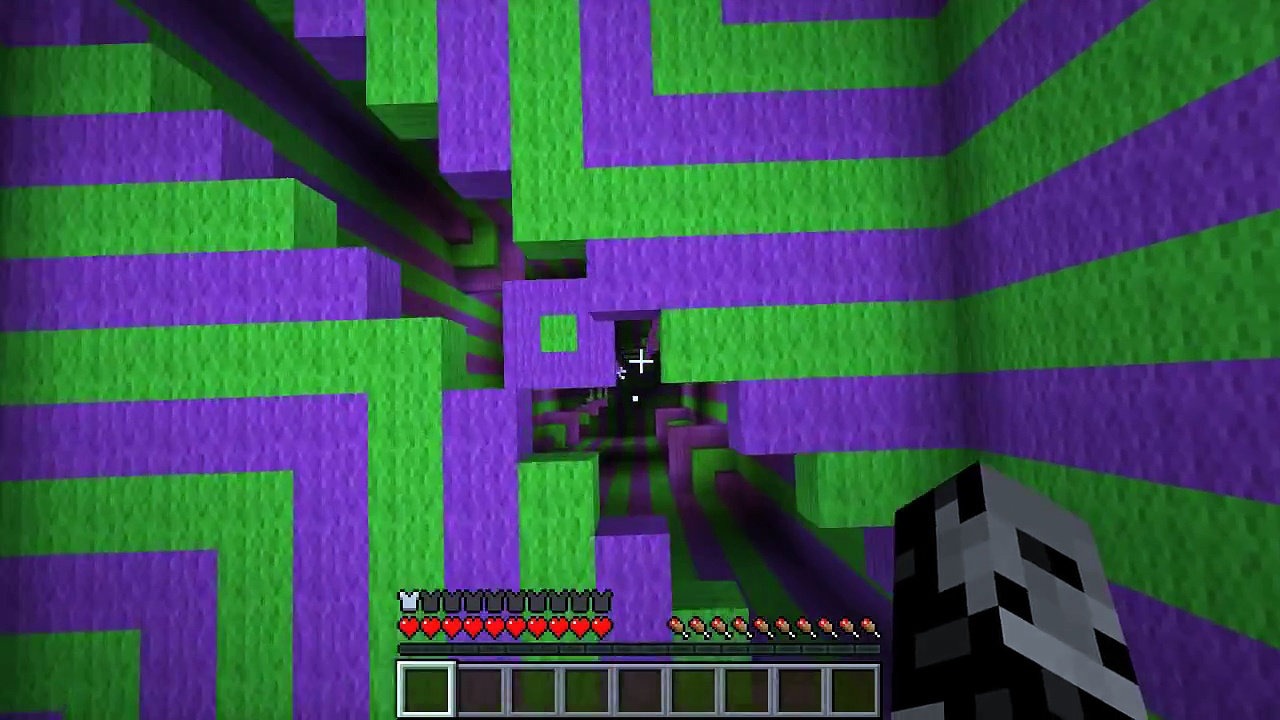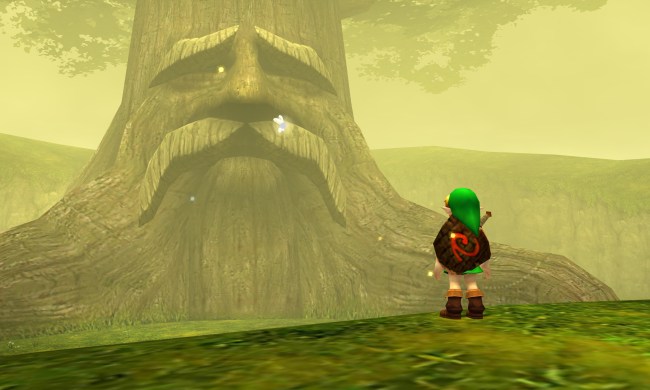
With that kind of massive player base, it should come as no surprise that some of the community’s creations are impressive downright ridiculous. Some projects are conceived and constructed by lone builders with a particular vision, while others are labors of love for big groups of players, working together for years to craft sprawling realms. Some structures are drawn directly from their authors’ imaginations, while some are painstakingly detailed models of previously realized worlds — fictional or otherwise. In any case, it would be downright rude to wax poetic about these creations without a little show-and-tell, so scroll on, dear reader, to see the best that the global Minecraft fraternity has to offer.
Something to keep in mind: Many of these maps are only compatible with specific versions of Minecraft. If you want to experience them for yourself, you might be required to install a separate launcher or texture pack.
Part I: Creative maps
These maps aren’t home to any puzzles, enemies, or narrative-driven gameplay — they’re just eye candy, here to be looked at and appreciated. Their creators spent countless hours pouring in bucketfuls of blood, sweat, tears, and cubes, and the results are simply spectacular.
Westeroscraft
Even if you don’t know anything about Minecraft, chances are that you’ve heard of Game of Thrones. HBO’s ultra-popular fantasy program — and its source novels by George R. R. Martin — have millions of fans around the world, and its expansive world has inspired creatives to come up with some really cool stuff. Still, it’s difficult to truly understand the love some fans have for the series until you’ve witnessed the ginormous (and we mean ginormous) world of Westeroscraft, a scale replica of the entire continent of Westeros. According to Martin, Westeros is approximately the size of South America, and project lead Jacob Granberry estimates that the in-game world (hosted on its own server; you need to download a separate launcher to get in) is scaled at about 1/100.
In other words: it’s freaking huge. Walking from the map’s northernmost point (the forest beyond the Wall) to its southernmost point (the Dornish sea) takes more than an hour in real time, and even traversing the “map” — of which there are two, a 3D version and a 2D version — is time consuming. King’s Landing, the capital of Westeros and its largest city, is monolithic; more than a billion blocks went into its creation, from Baelor’s Sept to the Red Keep. Though the world isn’t inhabited (yet — Granberry & co. still have designs on turning the project into a full-fledged RPG), it’s still alive; weather effects are surprisingly vivid, with snow swirling around Castle Black and blood-orange sunsets peeking through the willows at Highgarden. It’s all very official by this point; prospective contributors to Westeroscraft must submit “applications” to the team by building a location to prove their acuity and knowledge of the aesthetic.
Luccid Utopia: City of the Future
Aria Creations, a team of Minecraft builders, is known for crafting gorgeous, uber-detailed maps. From giant carnivorous flytraps to a wolf howling at the moon, Aria’s squad can create nearly anything — often, they take requests from fans or members of the greater Minecraft community, which can be used as launching points for private servers, among other things. For Aria’s most elaborate projects, they create super sweet time lapse videos showing the construction process (sped up, of course), with smooth camera work and relaxing electronic music that’s typical of Minecraft flythroughs. Luccid Utopia, probably their most popular creation, is a futuristic city built atop a tropical isle, replete with twisting highways and towering skyscrapers.
There’s something oddly satisfying about watching tiny specks fly around, structures rising out of the ground like some kind of crazy, detailed loading screen. Not only is the city a work of art — watching the time lapse is a neat way to see how Aria goes about their creative process, beginning with small infrastructure like streetlamps and moving gradually up to larger stuff. Luccid Utopia’s tallest building is so tall, in fact, that it actually pierces the cloud line, and it’s not even the coolest element. Watch closely for an Easter egg or two.
Crafting Azeroth
If you thought Westeroscraft was big…. You’re absolutely right. It’s humongous. Still, the size of pixelated Westeros pales in comparison to the sheer scale of Crafting Azeroth, a project created by one man which recreates the World of Warcraft in classic Minecraft style. Minecraftforum.com user Rumsey developed custom software that utilizes a process called “voxelization” to automatically detect textures in World of Warcraft and convert them to assets found in Minecraft, at scale. In order to do so, he created a unique software tool to help identify and match textures between the game engines; with more than 10,000 different textures in WoW, he asserts that the process took “many hours of work” (we believe him).
The result? A MASSIVE game world containing more than 100 billion blocks and spanning more than 500 square kilometers — the world is so large that Rumsey had to separate it into seven vertical layers, with a server-side plugin that automatically teleports players when they reach a height threshold. Currently, the map includes Kalimdor, the Eastern Kingdoms, Outland, Northrend, and all the areas added in the Cataclysm expansion (though instanced areas like dungeons and raids were omitted); Rumsey mentioned that he had planned on building Pandaria as well, though we don’t know if he’ll follow through. Either way, this is an absolutely mind-blowing project that should interest veterans of WoW. Click here to view an interactive map, and click here to check out some screenshots comparing the worlds.
Los Angelcraft
It’s unsettling to see downtown Los Angeles bereft of suffocating traffic. Los Angelcraft, a not-so-creatively named project from Planetminecraft.com user fujiwara1990, is the only chance you’ll ever get to explore the California city in isolation (though not quite a full replica), and it’s awesome. Without utilizing any non-native texture packs — he didn’t want to force fans to download extraneous content — fujiwara crafted a virtual metropolis to rival GTA: San Andreas’ Los Santos in scale, complete with a cadre of steel skyscrapers and streets lined with voxelated palm trees.
Despite never having visited Los Angeles, the map’s German author crafted the city with excruciating detail: each building is accessible, with furnished interiors, and you’ll find lots of cool L.A. landmarks like the Santa Monica Pier’s ferris wheel. Los Angelcraft doesn’t quite reach the scale of Westeroscraft or Crafting Azeroth, but it was created by just one man, without scripts or custom software. If you’re short on funds but still in need of a sunny vacation, why not go for a visit?
Aurora City
Since 2011, Romanian Minecrafter Ancient has been hard at work on his magnum opus: a wondrous, fictional locale known as Aurora City. Inspired by several major metropolitan areas across Asia, Aurora City is built using a unique texture pack that smooths out much of the blockiness and gives the city an authentic (if cartoony) aesthetic. Structures in Aurora are varied and detailed, with tons of signs featuring imagery and Chinese and Japanese logograms. From balconies to rooftops to flora, each element of the city is rendered with great care and, despite the map’s size, none of it ever feels reused or lazy.
The project — which Ancient has said he’ll “probably never finish” — is a labor of love, dotted with unique landmarks and covered with little things (like cell towers) that most builders overlook. A monorail track winds its way through Aurora’s streets and around its edges, and the city features a unique blend of contemporary architecture and traditional Japanese pagoda structures; parts of Aurora are even multi-tiered, with huge skyscrapers rising majestically out of the city’s profile. Cherry blossom trees and paper lanterns are everywhere, contributing to the distinctly Eastern atmosphere.
Part II: Adventure maps
These maps aren’t just showcases for their authors’ artistic talents — they’re meant to be played and enjoyed, utilizing Minecraft’s framework in unique and creative ways to become new games entirely.
Cake Defense 2
Australian Minecrafter Disco (sometimes stylized as disco_) is a legend among members of the community. He’s the architect behind tons of popular Minecraft maps and minigames, including a recreation of Plants vs. Zombies, a playable in-game guitar, and a hilarious temple dedicated to Markus Persson — a.k.a. Notch — the game’s creator. Disco has 24 different YouTube uploads with more than a million views each, and they’re all showing off cool creations of his. Cake Defense 2 is one of the most enjoyable multiplayer experiences available for Minecraft; the Mojang team actually included it as a minigame in the Minecraft Realms service.
In Cake Defense 2, the premise is simple: Defend against a horde of incoming enemies without dying or falling off the edge. It’s easier said than done, however, with the game getting increasingly chaotic and difficult as you progress through levels. A huge display on the wall lets players know which enemies are remaining in each wave, and you can even upgrade three separate statistics to boost your power along the way. Cake Defense 2 isn’t necessarily a new concept, but it’s very impressively put together, and it’s a ton of fun when you play with friends.
Legend of Zelda: Breath of the Wild
Okay, hear us out. Yes, we know that Breath of the Wild is already a video game. In fact, we played it, and we liked it — a lot. Still, there’s no real point in playing any game unless that game is also Minecraft, right? Luckily, Kiptrix (known as KSKISPER on game forums and social media) recreated Breath of the Wild’s Great Plateau area in the Minecraft engine, and it’s, well, breathtaking. The game uses tons of imported sound files, like the trademark Legend of Zelda “chime,” and he’s done an incredible job replicating the world in detail, from apple trees to cathedrals.
Just like in the full game, you’ve got to meet with a mysterious old man and find a strange tower, and several of Breath of the Wild‘s side quests have been boiled down into shorter versions suited for the experience. You’ll still find packs of angry Moblins wandering around, and the character models look great, as do the weapons and items. Fittingly, weapon durability is extremely low, and you’ll even hear the same kind of soft piano music wafting in an out as you adventure. The craziest part? Kiptrix hadn’t even played Breath of the Wild while he was making this — it was crafted entirely from promotional videos and demos. Yeah.
The Tourist
Most story-driven adventure maps in Minecraft are fun little diversions, rarely spanning more than 30 or 45 minutes. The Tourist — courtesy of French builder stratocrafteur — doesn’t just break the mold, it shatters the mold. Clocking in at more than four hours long, the map takes players on an adventure through Paris, unraveling a mystery with the highest of stakes. The creator imbued his story with a sense of humor, too, so despite the macabre circumstances you’ll get a few laughs if you pay attention.
The plot itself plays out in a series of huge, detailed locales, each underscored by kilometers’ worth of redstone — the type of blocks that power devices in Minecraft — and home to tons of little puzzles and scenarios for players to figure out. From the snowy streets of Paris to towering cathedrals and subway stations, stratocrafteur’s attention to detail will astound you, with excellent sound direction and music that drops in and out at opportune moments. Even puzzle veterans will find themselves stumped at certain times in The Tourist, and there are even five different redstone-powered minigames within the world to find and play. Plus, you can play with a friend!
Herobrine’s Mansion
If you like the idea of a more action-packed adventure map, check out Herobrine’s Mansion. Created by Minecraft collective Hypixel, the Mansion is home to six unique boss battles, hordes of different enemies to fight through, and lots of loot, including several themed armor sets. A custom texture pack adds some flavor to the map’s denizens and environs, with top-notch sound design that includes heart-pounding fight music. Compared to the relatively placid atmosphere in The Tourist, Herobrine’s Mansion is high octane, as you’ll find yourself frantically waving your sword at mobs of creepers while trying to survive. Even in survival mode, Minecraft is usually pretty relaxed, but this is a whole new ballgame.
In the mansion, you’ll find custom potions, secret rooms, and a shop. As you progress and upgrade your gear, enemies will get tougher and battles will become more panicked. Herobrine’s Mansion isn’t for the faint of heart, and even experienced adventurers with friends will sometimes taste defeat at the hands of Herobrine and his minions. If you have fun, make sure to check out the follow-up, Herobrine’s Return, which features an all new adventure with more creative boss fights and unique items to collect. Few experiences in Minecraft are as exciting.
Dropper maps
It’s hard to pick a single dropper map to showcase, because the concept has grown into a full-on sub-genre for Minecraft adventure maps. Pioneered by Belgian builder Bigre, the general idea is thus: Survive a series of drops from high places avoiding obstacles on the way down and usually landing in a small pool of water. It sounds simple — and it is, for the most part — but the theme became extremely popular, leading to the creation of dozens of dropper maps, each more ingenious and diabolical than the last. Some dropper maps feature hidden treasures partway down, and some offer alternative objectives to spice up the action.
Most dropper maps are home to several different drops, unlocking in a specific order and increasing in difficulty. Teleporters or elevators at the bottom of each drop generally return players to a sort of “hub,” from which they can select their next drop, though of course this varies by map. Builders tend to get creative with droppers, using unique perspectives and complicated level design to challenge players. There are so many different versions that you could spend days just dropping and marveling at the twists each Minecrafter uses to tweak the formula. Or, you could spend months watching YouTubers do it; it’s even easier to find Let’s Play videos than it is to find dropper maps.
